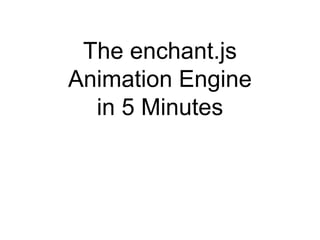
The Enchant.js Animation Engine in 5 Minutes
- 1. The enchant.js Animation Engine in 5 Minutes
- 2. Introductions Ryohei Fushimi (@sidestepism) Ubiquitous Entertainment, Inc. (UEI) Akihabara Research Center (ARC) 9leap Project Leader English Translation: Brandon McInnis (@BrandonUnfathom) enchant.js Technical Evangelist
- 3. If we want to make the bear move...
- 4. bear.addEventListener(“enterframe”, function(){ bear.x ++; }); // moves the bear to the right by one pixel every frame
- 5. He moves!
- 6. But he doesn’t stop...
- 7. bear.addEventListener(“enterframe”, function(){ if(bear.x < 100)bear.x ++; }); // moves the bear to the right by one pixel every frame IF the bear’s position on the x-axis is less than 100 //(x,y coordinates always start at (0,0) in the upper left-hand corner)
- 8. This time...
- 9. He stopped!
- 10. But...
- 11. But...
- 12. But...
- 13. What about movement like this?
- 15. kind of wordy... We use animation.enchant.js
- 17. We use tl.enchant.js Note: As of version v0.6, tl.enchant.js is now part of the enchant.js main library, and not a separate plugin. The following examples still work the same way, however.
- 18. tl : abbreviation for TimeLine We’ll explain this later.
- 19. // To move the bear to (120,120) over 30 frames (1 second by the default 30 fps) bear.tl.moveTo(120, 120, 30);
- 20. // First move the bear to (120, 120) over 30 frames, // then move the bear to (60,180) over 30 frames. bear.tl.moveTo(120, 120, 30).moveTo(60, 180, 30);
- 21. // Move the bear to (120, 120) over 30 frames, // then move the bear to (60, 180) over 30 frames, // then move the bear to (180, 90) over 30 frames. bear.tl.moveTo(120, 120, 30) .moveTo(60, 180, 30) .moveTo(180, 90, 30);
- 22. Order of processing moveTo(120, 120, 30) Representation of moveTo(180, 90, 30) how timeline commands are stacked in a queue. moveTo(160, 30, 30)
- 23. Movement Feature #0 moveTo/moveBy bear.tl.moveTo(120, 120, 30); // absolute movement to (120, 120) bear.tl.moveBy(40, 40, 30); // relative movement by (+40, +40)
- 24. Feature #1 Fade in fadeIn bear.tl.fadeIn(30); // fade in over 30 frames
- 25. Feature #2 Changing size scaleTo/scaleBy bear.tl.scaleTo(3, 30); // scale the bear by a factor of 3 (3x normal size) over 30 frames
- 26. Feature #3 Specified time delay delay bear.tl.delay(30).fadeIn(30); // wait 30 frames, then fade the bear in over 30 frames
- 27. Feature #4 Run a function then bear.tl.delay(30).then(function(){ scene.removeChild(bear); }); // wait 30 frames, then remove the bear from the screen
- 28. Feature #5 Run multiple functions cue bear.tl.cue({ 10: function(){ ... }, 20: function(){ ... }, 30: function(){ ... }, 50: function(){ ... } }); // execute functions at specified frames (i.e. at 10 frames after execution, run first function; 20 frames after execution, run second function; etc.)
- 29. Feature #6 Tweening tween bear.tl.tween({ x: 120, y: 120, scaleX: 3, scaleY: 3, time: 100 }); // perform multiple tl operations simultaneously over 100 frames // Did you know? The word “tween” comes from the word “inbetweening,” meaning to create animation frames between two keyframes. http://en.wikipedia.org/wiki/Inbetweening
- 30. Feature #7 Parallel Execution and bear.tl.fadeIn(30).moveTo(120, 120, 30) // fade in over 30 frames, and then move to (120,120) over 30 frames bear.tl.fadeIn(30).and().moveTo(120, 120, 30) // fade in over 30 frames and move to (120,120) over 30 frames simultaneously!
- 31. Feature #8 loops loop bear.tl.fadeIn(30).fadeOut(30).loop(); // loop an animation of fading in over 30 frames, and then fading out over 30 frames
- 32. Feature #9 Fast-forward skip bear.tl.skip(100); // fast-forward by 100 frames
- 33. Feature#10 Execute a function repeatedly repeat Feature#11 Pause/resume the queue pause / resume Feature#12 Erase the entire queue clear
- 34. Execute a function, wait for it to complete, Feature#13 and then move on waitUntil Feature#14 Define an action action Feature#15 Erase from a scene removeFromScene
- 35. Feature#16 Time-based animation setTimeBased bear.tl.setTimeBased(); bear.tl.fadeIn(3000) // make all tl animation functions accept duration values in milliseconds instead of frames, then fade in the bear over 3000 ms (3 seconds) // this can be reversed with setFrameBased(); // for more information on time-based animation with enchant.js, see Kevin Kratzer’s tutorial at http://bit.ly/XcLHDC
- 36. You must remember EASING
- 37. If the rate at which a sprite moves changes over time...
- 38. this is called EASING! If this is confusing, please see the first part of http://bit.ly/109CYbP for an explanation of the concept of easing, using Lego animation.
- 39. // Easing bear.tl.moveTo(120, 120, 30, enchant.Easing.QUAD_EASEINOUT); bear.tl.tween({ x: 120, Specify via a y: 120, function scaleX: 3, scaleY: 3, time: 100, easing: enchant.Easing.QUAD_EASEINOUT }));
- 40. Several preset easing functions can be chosen from. QUAD_ QUBIC_ QUINT_ SIN_ EASEIN enchant.Easing. BACK_ + EASEOUT CIRC_ ELASTIC_ EASEINOUT BOUNCE_ EXPO_
- 41. The Tweener Transition Cheat Sheet http://bit.ly/3u7B6 explains these movements
- 42. As you can see, many different functions and features exist for animation and timelines in the animation engine of enchant.js.
- 43. Check it out on github if you haven’t already!
